~~ Book Set 1729050615 ~~
Histoire Naturelle,
Civile et Ecclésiastique
de L'Empire du Japon ~~ by Engelbert Kaempfer
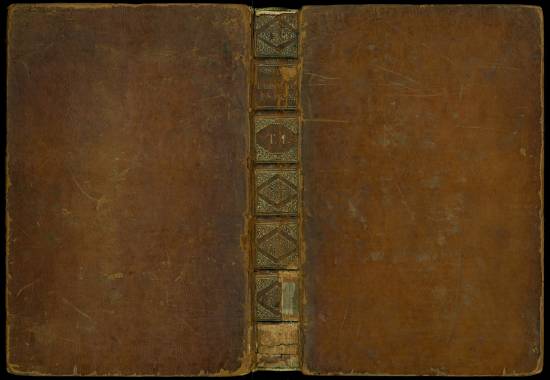
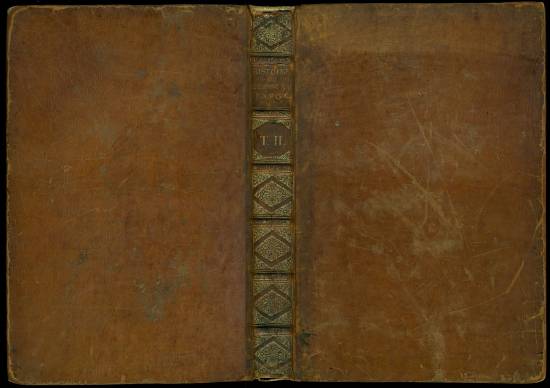
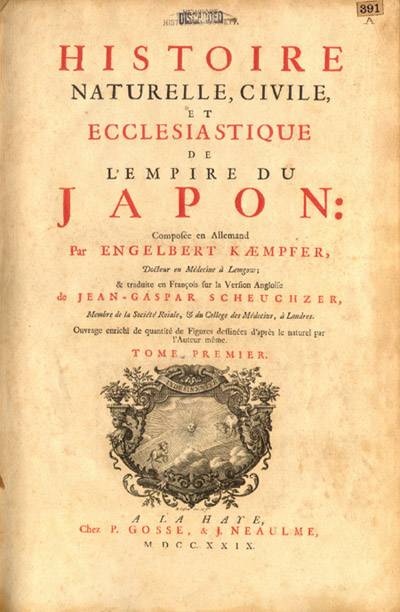
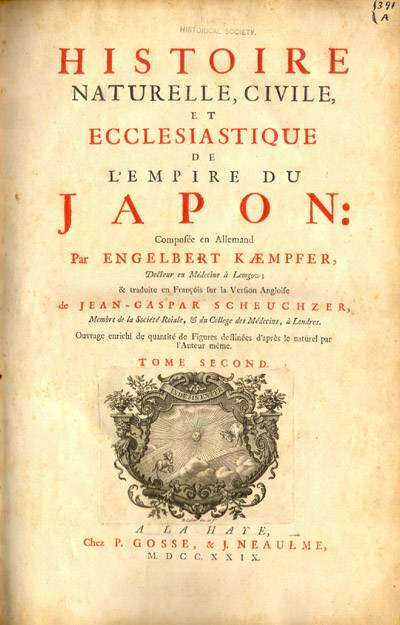
Condition. This set is in Good+ condition. However, it is lacking one of the 45 plates. The missing plate is Plate VIII, A Map of the Empire of Japan. The other 44 plates are present. The book is bound in contemporary leather. The spine covering has gilt decoration and lettering. The edges are stained red. The inside of the covers (front and back) have colored paper covering. There is a free page adjacent to the front and back inside covers.
Both books have a "Newport Historical Society" hand stamp and number at the top of the title page. There are no other library or society indicia. Based upon my inquiry, the Newport Historical Society advised me that they find no evidence that the work is "...still a part of the collection of the Newport Historical Society." The Society also stated it is likely that the books were deaccessed by the Society in the 1960s. A copy of the letter from the Society in this regard will be provided with the books. There is no extra (second) illustrated title page in Volume I which is apparently sometimes found in that volume.
The boards are heavily scraped. The spine covering is in poor condition with portions missing and it is beginning to detach from the block along the edges.
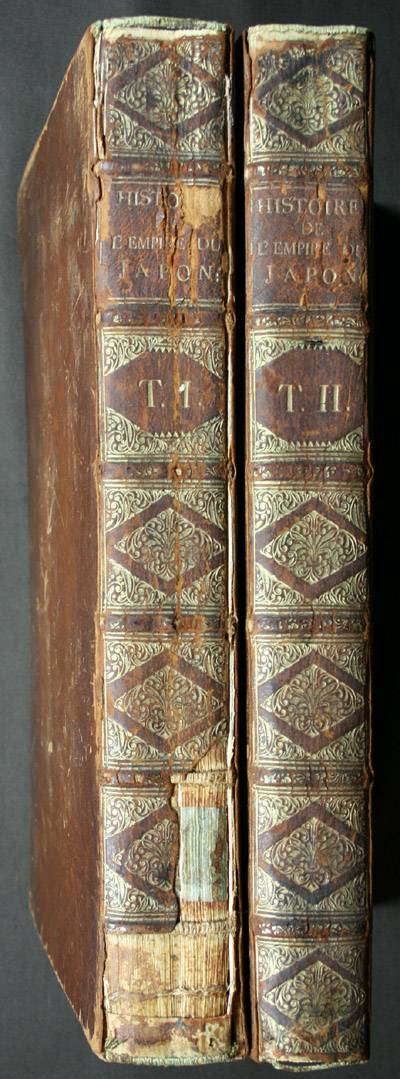
While the binding is solid, there is separation at some points when the book is opened at the points where signatures join. This is particularly so in Volume I where the plate section ends and the text section begins.
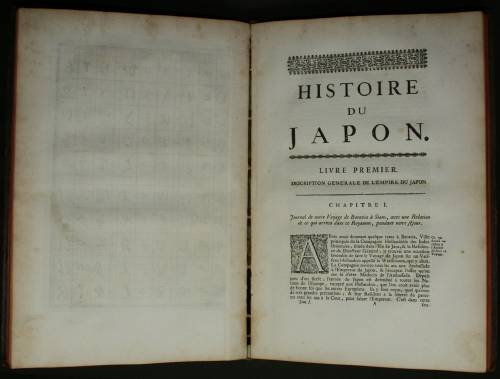
The book has heavy to medium foxing. It is heaviest at the front and back and moderates significantly thereafter. Below is a typical view of interior pages.
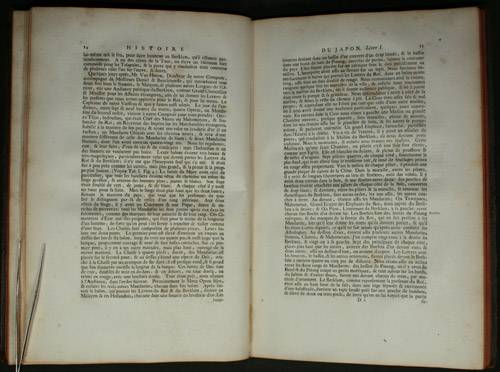
The plates (actually designated "Tabs") have light to medium foxing and marginal toning and are cleaner than the text pages. I would rate them as Very Good. There are minor margin tears but none enter the image area. The folding plates are all properly folded with no extra creases. The images below are the actual plates in this book. Plate VIII is missing and there is evidence of where it was crudely removed.
The text portions of the book have been checked page by page. All text pages are present.
Volume I is text and plates and has:
- Title Page (1 page, no printing on back),
- Dedication page to Henry Friso (1 page),
- "Epitre"(pages 1-3),
- "Table des Chapitres" (2 pages),
- "Preface de L'Auteur" and "La Vie de L'Auteur" and "Discours Preliminaire du Traducteur" and "Explication des XLV Planches" (pages i-li),
- 44 plates (1 missing),
- Text pages 1-217.
Volume II is all text and it has:
- Title Page (1 page, no printing on back),
- "Livre" (2 pages),
- Text pages 1-313,
- Appendix 1 & 2 (pages 1-87),
- Index - "Table of Matieres" (pages 88-96).
There is a red ink/blood smear in the margin of Appendix page 54. It is approximately 2x2cm. There are two appendix pages with the number 73 and they have different text.
Kaempfer, Engelbert:
Histoire Naturelle, Civile et Ecclésiastique de L'Empire du Japon: Compofée en Allemand par Engelbert Kaempfer, Docteur en Medecine a Lemgow, & traduite en François fur la Version Angloise de Jean-Gaspar Scheuchzer, Membre de la Société Roiale, & du Collège des Médecins, à Londres. Ouvrage enrichi de quantite de Figures deflinees d'apres le naturel par L'Auteur meme, The Hague (A la Haye), Chez P. Gosse, & J. Neaulme, 1729 (MDCCXXIX), large 4to (9 1/2 x 14 in - 24 x 36 cm), two volumes (tomes).
Volume I, title page printed in red and black with engraved vignette by D. Coster, dedication page with engraved head-piece, "Epiture" (3 pages), table of contents (2 pages), i-lii pages of "Preliminaire" which include the author's preface, the life of the author, an introduction by the translator, a listing and explanation of the plates (called tabs), 45 copper engraved plates on fine laid paper, including maps, plans, views, tea plant and utensils, medicine and flora and fauna plates and text pages 1-217 following the plates. It appears that in some editions there is a second engraved title page.
Volume II, title page printed in red and black with engraved vignette by D. Coster. It contains a "Livre" (2 pages), text pages (pages 1-313), Appendix 1 & 2 (pages 1-87) and an index - "Table of Matieres" (pages 88-96).
The plates. The set contains 45 fine copper engraved plates, all found in volume I. These were prepared under the supervision of the translator Scheuchzer and many are said to be based upon drawings and sketches in Kaempfer's manuscripts. There are 35 double page plates (3 are folding), 10 single page plates (9 are folding). The double page plates are mounted left to right. In some bindings, the plates are not bound directly into the book. Instead, they are attached to a linen type "T" type stub/strip which is bound into the book. This is a very high quality technique and the double page plates are actually a continuous sheet with no loss of image between the two sides of the plate. To see the plate binding using this technique, click here.
The following is a precise listing of all pages in the Volumes I and II that I have examined.
Volume I is text and plates and has:
- Title Page (1 page, no printing on back),
- Dedication page to Henry Friso (1 page),
- "Epitre"(pages 1-3),
- "Table des Chapitres" (2 pages),
- "Preface de L'Auteur" and "La Vie de L'Auteur" and "Discours Preliminaire du Traducteur" and "Explication des XLV Planches" (pages i-li),
- 44 plates (1 missing),
- Text pages 1-217.
Volume II is all text and it has:
- Title Page (1 page, no printing on back),
- "Livre" (2 pages),
- Text pages 1-313,
- Appendix 1 & 2 (pages 1-87),
- Index - "Table of Matieres" (pages 88-96).
Engelbert Kaempfer (1651-1716), a physician and botanist, served as the medical officer at the Dutch concession on Deshima from 1690-1692. In his position, and because of his background, he had a rare opportunity and ability to observe and record Japanese life, culture and natural history. He also participated in two trips from Deshima to Jedo (Tokyo) and carefully documented his observations. All this occurred during a period where Japan was secluded from the Western world. On his return to Germany in 1693 he published an account of his travels under the title of Amoenitates Exoticae. However, his extensive manuscripts regarding Japan remained unpublished. These were obtained by Sir Hans Sloane who had them translated into English by J.G. Scheuchzer. Thus, in 1727, the first edition of Kaempfer's comprehensive account of Japan appeared in English as The History of Japan. This was followed in 1729 by translations in both Dutch and French. This is the 1729 French edition which is a translation of the English edition. A second French edition (abridged pocket book size/12mo) was published in a three volume set by Uytwerf in Amsterdam in 1732.
Until the Narrative of the Perry Expedition to Japan published in 1856-7, these works derived from Kaempfer's manuscripts were the primary source of information about Japan in the Western world.
Illustrated Title Pages in Red and Black
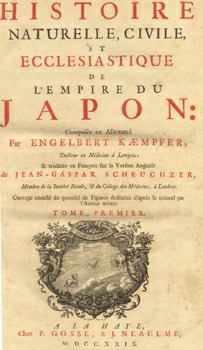
Title Page Volume 1
Title Page Volume 2
Extra Engraved Title Sometimes Found in Volume I (Not in this Set However)
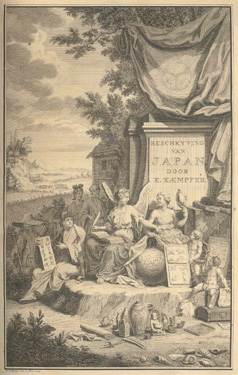
Table of Contents, Volume 1
Table of Contents, Volume 2
Example of a Double Page Fold Out Plate (Plate XIX)
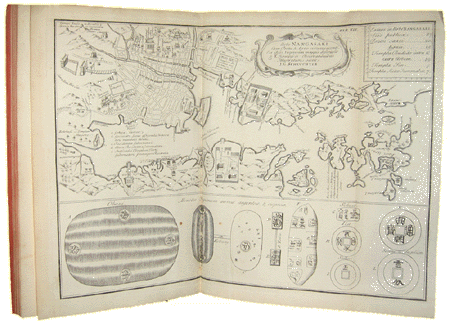
The descriptions provided for the plates (below) are derived from the 1906 facsimile edition of the 1727 first English edition of this set. For more information on that set, click here.
Plate I (4 figures - double page)
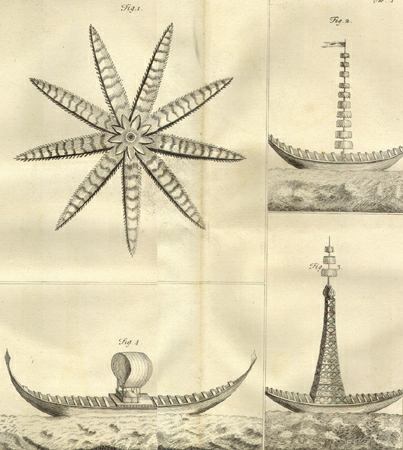 A Curious Star-fish with nine rays,
A Prow or boat such as the Siamites use at their funerals
A Prow or boat such as the Siamites use at their funerals
The Boat on board which were carried the letters for the King
Plate II (double page)
The plan of Juthia, the capital of Siam
Plate III (7 figures - double page)
A Curious Star-fish with nine rays,
A Prow or boat such as the Siamites use at their funerals
A Prow or boat such as the Siamites use at their funerals
The Boat on board which were carried the letters for the King
Plate II (double page)
The plan of Juthia, the capital of Siam
Plate III (7 figures - double page)
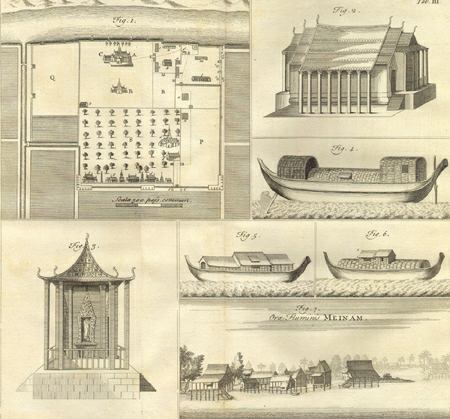 The plan of the Royal Palace of Siam
An inhabited Boat of the Siamites
An inhabited Boat of the Siamites
An inhabited Boat of the Siamites
A view of the river Meinam
Plate IV (fold-down)
The Pyramid Pukathon near Juthia
Plate V (4 figures - double page)
The plan of the Royal Palace of Siam
An inhabited Boat of the Siamites
An inhabited Boat of the Siamites
An inhabited Boat of the Siamites
A view of the river Meinam
Plate IV (fold-down)
The Pyramid Pukathon near Juthia
Plate V (4 figures - double page)
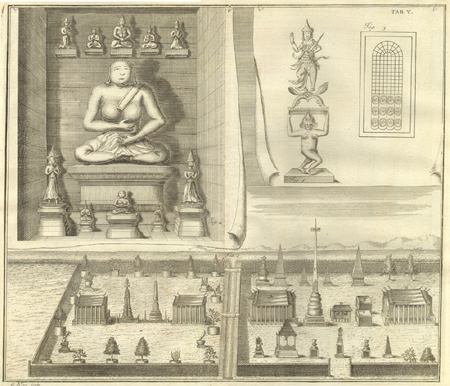 A view of the two Courts of Berklam's Temple
A large Idol a stone held very sacred by the Siamites.
Monstrous Idols
Plate VI (7 figures - double page)
A view of the Temple of the Siamites
The front of the said Temple
An open House with a bell hanging in it
A Pyramid such as the Siamites commonly place about
their Temples
A large Pyramid in the second Court of Berklam's Temple
A sort of an Altar, with a cup or pot at
the top
A Pyramid such as the Siamites commonly place
about their Temples
A Pyramid called Pra Pian
A Pyramid called Pra Tsiebi
Plate VII (single page)
A view of the two Courts of Berklam's Temple
A large Idol a stone held very sacred by the Siamites.
Monstrous Idols
Plate VI (7 figures - double page)
A view of the Temple of the Siamites
The front of the said Temple
An open House with a bell hanging in it
A Pyramid such as the Siamites commonly place about
their Temples
A large Pyramid in the second Court of Berklam's Temple
A sort of an Altar, with a cup or pot at
the top
A Pyramid such as the Siamites commonly place
about their Temples
A Pyramid called Pra Pian
A Pyramid called Pra Tsiebi
Plate VII (single page)
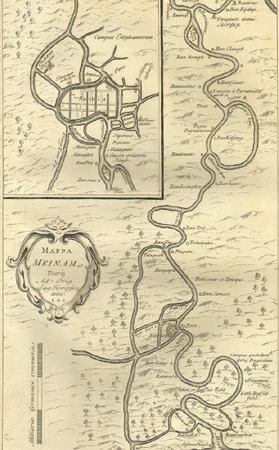 A Map of the course of the river Meinam
Plate VIII (double page) - (Missing from this Book)
A map of the Empire of Japan
"Imperium Japonicum in Sexaginta et Octo"
(title in 1727, History of Japan version)
(17.7 x 20.2 in - 46 x 53 cm)
Plate IX (8 figures - double page)
A Map of the course of the river Meinam
Plate VIII (double page) - (Missing from this Book)
A map of the Empire of Japan
"Imperium Japonicum in Sexaginta et Octo"
(title in 1727, History of Japan version)
(17.7 x 20.2 in - 46 x 53 cm)
Plate IX (8 figures - double page)
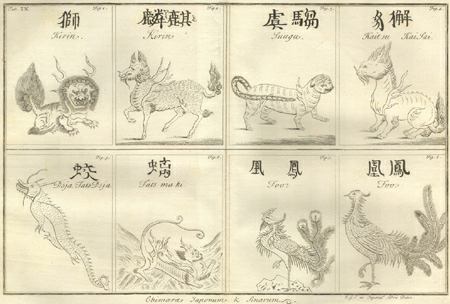 Kirin, a chimerical Animal as represented by
the Chinese
The same according to the Japanese
Suugu, a Chimera of the Japanese
Kaitsu, a Chimera of the Japanese
Dsja, the Dragon, according to the Japanese
Tatsmaki, a water Dragon, by the Japanese
Foo, a chimerical Bird of Paradise, according
to the Chinese
Foo, a chimerical Bird of Paradise, as figured
by the Japanese
Plate X (7 figures - double page)
Kirin, a chimerical Animal as represented by
the Chinese
The same according to the Japanese
Suugu, a Chimera of the Japanese
Kaitsu, a Chimera of the Japanese
Dsja, the Dragon, according to the Japanese
Tatsmaki, a water Dragon, by the Japanese
Foo, a chimerical Bird of Paradise, according
to the Chinese
Foo, a chimerical Bird of Paradise, as figured
by the Japanese
Plate X (7 figures - double page)
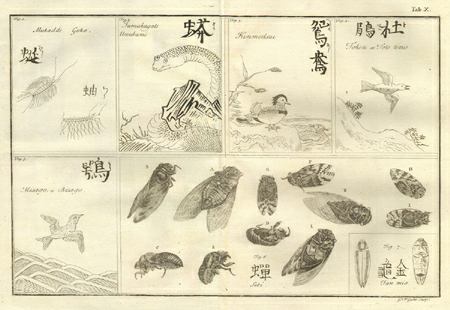 Mukadde, a Forty-leg
Jamakagats, a large snake
Kinmodsui, a beautiful duck
Foken, a night bird
Misago, a sea bird of the hawk kind
Sebi, a sort of beetel. San-mio, a sort of
Spanish-flies
Plate XI (8 figures - double page)
Mukadde, a Forty-leg
Jamakagats, a large snake
Kinmodsui, a beautiful duck
Foken, a night bird
Misago, a sea bird of the hawk kind
Sebi, a sort of beetel. San-mio, a sort of
Spanish-flies
Plate XI (8 figures - double page)
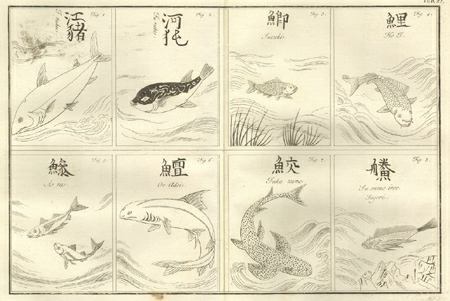 Iruku, a known fish
Furube, a blower fish
Susuki, a bald head
Koi, a fish not unlike a carp
Ara, a Jacob's Ewertz
Ooadsi, a sort of Maasbancker
Fukasame, the fish of whose skin they made the
Shagrin - Cases
Susumoiwo, a needle fish
Plate XII (8 figures - double page)
Iruku, a known fish
Furube, a blower fish
Susuki, a bald head
Koi, a fish not unlike a carp
Ara, a Jacob's Ewertz
Ooadsi, a sort of Maasbancker
Fukasame, the fish of whose skin they made the
Shagrin - Cases
Susumoiwo, a needle fish
Plate XII (8 figures - double page)
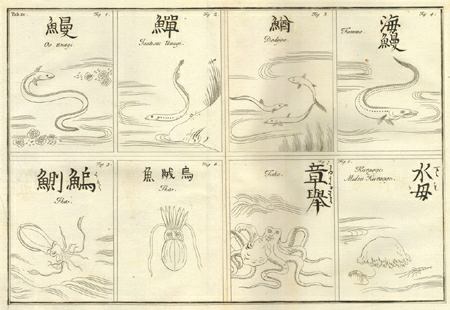 Oounagi, a sort of Eel much larger than
the common
Jaatzme Unagi, an eel with eight eyes
Doodsio, a fish with a very large head in
proportion to the body
Fammo, a Conger Eel
Ika, a common sea-qualm according to the
Chinese
Ika, as figured by the Japanese
Jako or Sepia, another sea-qualm
Kuragge, another sea-qualm
Plate XIII (8 figures - double page)
Oounagi, a sort of Eel much larger than
the common
Jaatzme Unagi, an eel with eight eyes
Doodsio, a fish with a very large head in
proportion to the body
Fammo, a Conger Eel
Ika, a common sea-qualm according to the
Chinese
Ika, as figured by the Japanese
Jako or Sepia, another sea-qualm
Kuragge, another sea-qualm
Plate XIII (8 figures - double page)
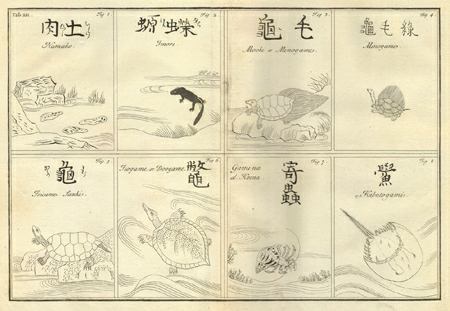 Namako, called Kafferkull, by the Dutch
at Batavia
Imori, a black water Lizard
Mooki, according to the Chinese
Mooki, an emblematical Tortoise, as
figur'd by the Japanese
Isicame, the Land tortoise
Jogame, the Water tortoise
Gamina, soldier's crab
Kabutogami, a singular crab
Plate XIV (9+1 figures - double page)
Namako, called Kafferkull, by the Dutch
at Batavia
Imori, a black water Lizard
Mooki, according to the Chinese
Mooki, an emblematical Tortoise, as
figur'd by the Japanese
Isicame, the Land tortoise
Jogame, the Water tortoise
Gamina, soldier's crab
Kabutogami, a singular crab
Plate XIV (9+1 figures - double page)
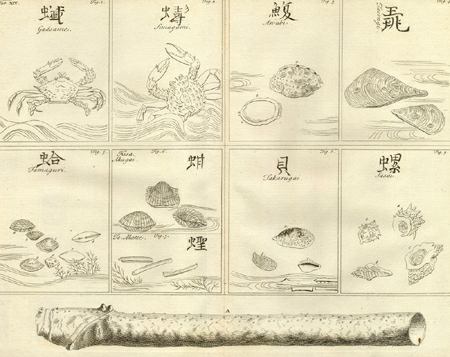 Hind-Claw of the Simagani
Gadsame, a crab with the upper shell tapering
into a point on both sides
Simagani, a striated pocket-crab
Awabi, an open Univalve
Tairagi, a sort of Pinna
Famaguri, bivalves, smooth and white within
Kisa, bivalves with deep furrows
Te or Matee, oblong thin bivalves gaping
at both ends
Takaragai, or Cowries
Sasai, a large Turbinated univalve
Plate XV (double page)
Hind-Claw of the Simagani
Gadsame, a crab with the upper shell tapering
into a point on both sides
Simagani, a striated pocket-crab
Awabi, an open Univalve
Tairagi, a sort of Pinna
Famaguri, bivalves, smooth and white within
Kisa, bivalves with deep furrows
Te or Matee, oblong thin bivalves gaping
at both ends
Takaragai, or Cowries
Sasai, a large Turbinated univalve
Plate XV (double page)
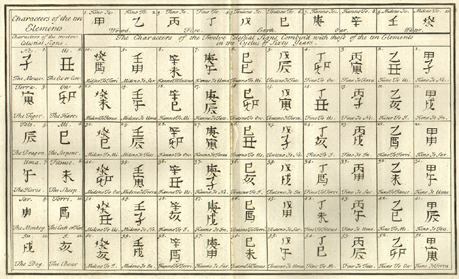 Characters of the Elements and the
Celestial Signs
Plate XVI (double page)
The names of the Deities, Chinese and
Japanese Emperors
Plate XVII (double page)
Characters of the Elements and the
Celestial Signs
Plate XVI (double page)
The names of the Deities, Chinese and
Japanese Emperors
Plate XVII (double page)
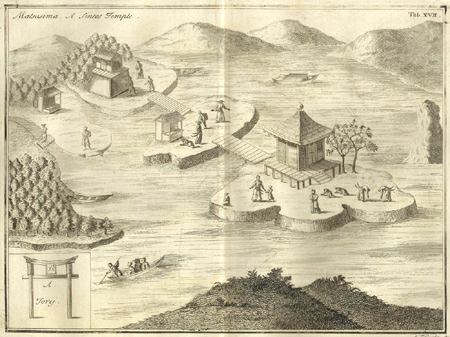 A view of Matsusima, a Sintos Temple
Plate XVIII (double page)
A view of the Temple of Tensio Daisin
at Isje
Plate XIX (Map + 11 figures - double page and fold out)
A view of Matsusima, a Sintos Temple
Plate XVIII (double page)
A view of the Temple of Tensio Daisin
at Isje
Plate XIX (Map + 11 figures - double page and fold out)
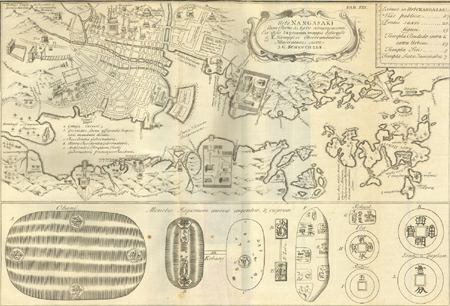 A Map of the City of Nagasaki, and of the
adjacent country
The Kobanj, or Cobang
An Obani in gold
A large lump of silver, with several
impressions
Both sides of a double Senni
An Ita or Schuit or silver; a Senni
or Putjos
An Itzebo in gold
Plate XX (6 figures - double page)
The manner in which Imperial Orders, etc.,
are put up in Publick places
The privilege granted to the Dutch in 1611
The Superscription of the renew'd privilege
granted to Henry Brouwer
The Seal of the Emperor Ongoschiosama
The Seal of the Emperor Taitokouynsama
The General form of the Oath in Japan
Plate XXI (10 figures - double page)
A Biosju or Memorial Table
A Biosju or Memorial Table
The trunks and Adofski
The saddle
The Adofski by itself
A pleasure boat with the sails, flags,
banners etc
A pleasure boat with the sails, flags,
banners etc
A Japanese merchant ship
A view of the stern of a merchant ship
The figure of the black horned Giwon,
an Idol of the Japanese
Plate XXII (2 figures - double page)
A Map of the City of Nagasaki, and of the
adjacent country
The Kobanj, or Cobang
An Obani in gold
A large lump of silver, with several
impressions
Both sides of a double Senni
An Ita or Schuit or silver; a Senni
or Putjos
An Itzebo in gold
Plate XX (6 figures - double page)
The manner in which Imperial Orders, etc.,
are put up in Publick places
The privilege granted to the Dutch in 1611
The Superscription of the renew'd privilege
granted to Henry Brouwer
The Seal of the Emperor Ongoschiosama
The Seal of the Emperor Taitokouynsama
The General form of the Oath in Japan
Plate XXI (10 figures - double page)
A Biosju or Memorial Table
A Biosju or Memorial Table
The trunks and Adofski
The saddle
The Adofski by itself
A pleasure boat with the sails, flags,
banners etc
A pleasure boat with the sails, flags,
banners etc
A Japanese merchant ship
A view of the stern of a merchant ship
The figure of the black horned Giwon,
an Idol of the Japanese
Plate XXII (2 figures - double page)
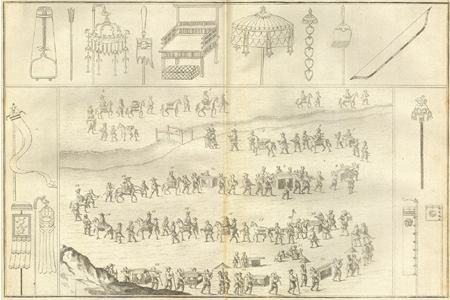 Some Banners
Umbrellas
A bow, arrow and quiver
Pikes of state
The Chair of State
The retinue of the Dutch Ambassadors in
their journey to Court
Plate XXIII (12 figures - single page foldout)
A particular map of the. Author's Journey from
Nagasaki, over the Island Kiusju,to Kokura
Plate XXIV (double page - foldout)
A particular Map of the voyage from Kokura to
Simonoseki and thence to Osacca
Plate XXV (double page)
Some Banners
Umbrellas
A bow, arrow and quiver
Pikes of state
The Chair of State
The retinue of the Dutch Ambassadors in
their journey to Court
Plate XXIII (12 figures - single page foldout)
A particular map of the. Author's Journey from
Nagasaki, over the Island Kiusju,to Kokura
Plate XXIV (double page - foldout)
A particular Map of the voyage from Kokura to
Simonoseki and thence to Osacca
Plate XXV (double page)
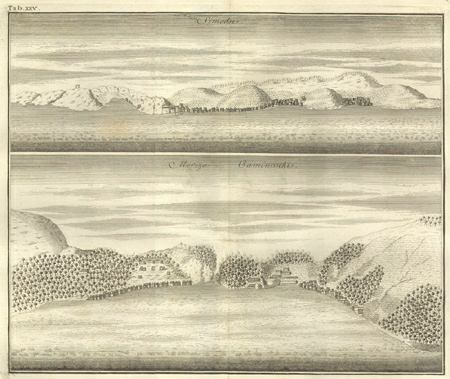 A view of the Streights of Caminoseki, and the
two villages Morizu and Caminoseki
A view of Simodsi or Sijmotsui
Plate XXVI (double page fold out)
A view of the town and harbour of Muru, and its
castle
Plate XXVII (single page foldout and down)
A view of the Streights of Caminoseki, and the
two villages Morizu and Caminoseki
A view of Simodsi or Sijmotsui
Plate XXVI (double page fold out)
A view of the town and harbour of Muru, and its
castle
Plate XXVII (single page foldout and down)
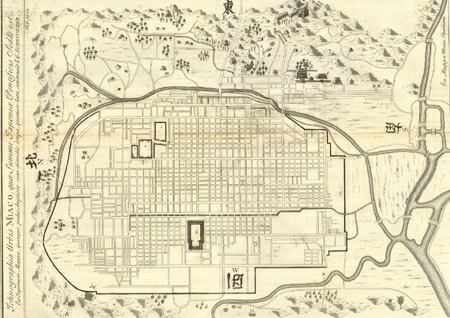 The ground-plot of the town of Miaco the residence of
the Ecclesiastical Hereditary Emperor of Japan
Plate XXVIII (double page)
A particular Map of the road from Osacca to Miaco, and
from thence to Fammamatz
Plate XXIX (single page - fold down)
The ground-plot of the town of Miaco the residence of
the Ecclesiastical Hereditary Emperor of Japan
Plate XXVIII (double page)
A particular Map of the road from Osacca to Miaco, and
from thence to Fammamatz
Plate XXIX (single page - fold down)
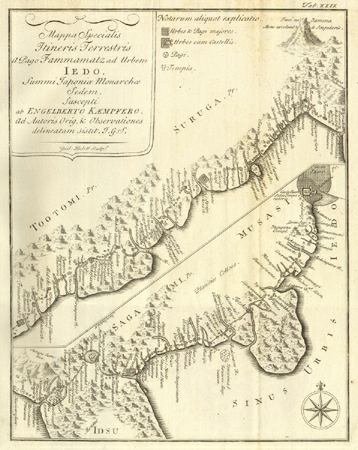 A particular map of the road from Fammamatz to Jedo,
the residence of the Secular Monarch of Japan
Plate XXX (double page)
A particular map of the road from Fammamatz to Jedo,
the residence of the Secular Monarch of Japan
Plate XXX (double page)
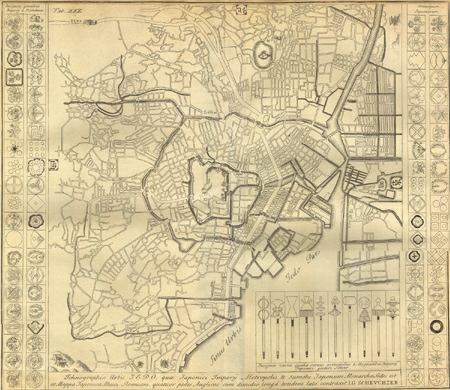 A ground-plot of the city of Jedo, the Capital of the
Japanese Empire
Plate XXXI (double page)
The hall of hundred mats
Musical instruments of the Japanese
Plate XXXII (double page)
A ground-plot of the city of Jedo, the Capital of the
Japanese Empire
Plate XXXI (double page)
The hall of hundred mats
Musical instruments of the Japanese
Plate XXXII (double page)
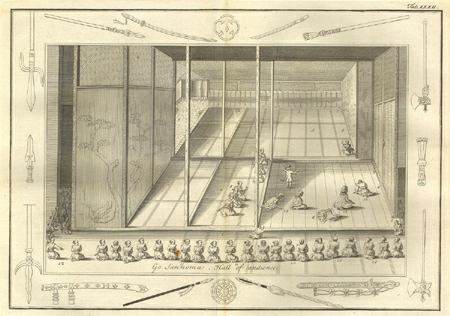 The hall of audience of the Dutch Ambassadors
Arms of the Japanese (many items depicted)
Plate XXXIII (14 figures - double page)
A ground-plot of the hot bath near Urissijno
A ground-plot of the town of Kokura
A view of the town and castle of Quano
A view of the town and castle of Mijah
A large Gum Gum or bell
Kurumado, a temple near Miaco
A ground-plot of the Simmios temple
A singular semi-circular bridge leading to
that temple
Pillars or bound stones,
A shuit of silver as they are commonly nailed to
Proclamation Posts
Three instruments usually carried before
criminals in publick executions
Plate XXXIV (double page)
The hall of audience of the Dutch Ambassadors
Arms of the Japanese (many items depicted)
Plate XXXIII (14 figures - double page)
A ground-plot of the hot bath near Urissijno
A ground-plot of the town of Kokura
A view of the town and castle of Quano
A view of the town and castle of Mijah
A large Gum Gum or bell
Kurumado, a temple near Miaco
A ground-plot of the Simmios temple
A singular semi-circular bridge leading to
that temple
Pillars or bound stones,
A shuit of silver as they are commonly nailed to
Proclamation Posts
Three instruments usually carried before
criminals in publick executions
Plate XXXIV (double page)
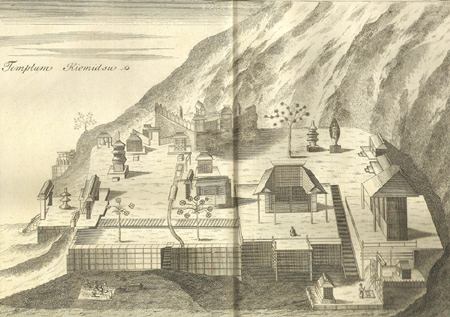 A view of the Kiomeds temple at Miaco
Plate XXXV (single page - foldout)
A view of the Daibods temple at Miaco
Plate XXXVI (single page - foldout)
A view of a Quanwon temple at Miaco wherein
are 33,333 Idols
Plate XXXVII (single page - foldout and down)
The idol of Quanwon sitting on a Tarate flower
Plate XXXVIII (double page)
A view of the Kiomeds temple at Miaco
Plate XXXV (single page - foldout)
A view of the Daibods temple at Miaco
Plate XXXVI (single page - foldout)
A view of a Quanwon temple at Miaco wherein
are 33,333 Idols
Plate XXXVII (single page - foldout and down)
The idol of Quanwon sitting on a Tarate flower
Plate XXXVIII (double page)
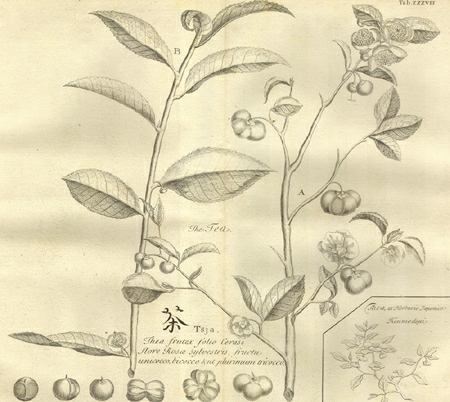 The tea shrub
Plate XXXIX (double page - 6+ figures)
The tea shrub
Plate XXXIX (double page - 6+ figures)
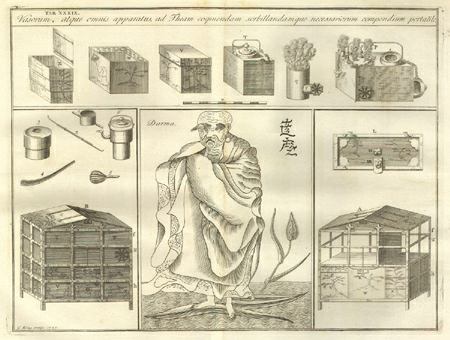 Darma, an eminent saint of the Japanese
The forepart of a portable machine, containing a
whole set of instruments for keeping, making and
drinking of tea
The back part of the same machine
The hanging valve of wood
The larger brass vessel
The smaller brass vessel
The wind-oven
The larger wooden case
The smaller wooden case
Three smaller wooden cases
The dishes and instruments requisite for making
and drinking the tea
The Scale
Plate XL (double page)
A branch of the true Paper tree: a branch of the
spurious Paper-tree
Plate XLI (double page)
Oreni, a beautiful Alcea
Plate XLII (single page, small foldout)
Sanekadsura, a shrub
Plate XLIII (single page - 6 figures)
Darma, an eminent saint of the Japanese
The forepart of a portable machine, containing a
whole set of instruments for keeping, making and
drinking of tea
The back part of the same machine
The hanging valve of wood
The larger brass vessel
The smaller brass vessel
The wind-oven
The larger wooden case
The smaller wooden case
Three smaller wooden cases
The dishes and instruments requisite for making
and drinking the tea
The Scale
Plate XL (double page)
A branch of the true Paper tree: a branch of the
spurious Paper-tree
Plate XLI (double page)
Oreni, a beautiful Alcea
Plate XLII (single page, small foldout)
Sanekadsura, a shrub
Plate XLIII (single page - 6 figures)
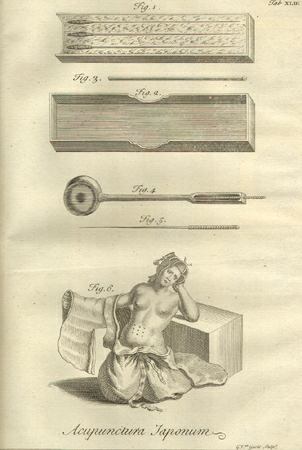 The Silver needles in the case
The covering of the said case
One of the gold needles taken out
The hammer
A brass pipe to guide the needles in pricking
The Acupunctura, or needle pricking of the Japanese
for curing the cholick
Plate XLIV (double page)
The Silver needles in the case
The covering of the said case
One of the gold needles taken out
The hammer
A brass pipe to guide the needles in pricking
The Acupunctura, or needle pricking of the Japanese
for curing the cholick
Plate XLIV (double page)
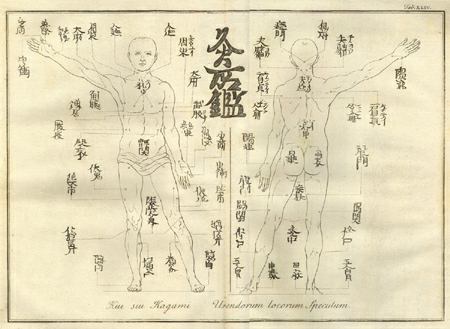 Two schemes shewing what parts of the human body are
to be burnt with the Moxa in several distempers
Plate XLV (double page)
Three several alphabets of the Japanese language
Two schemes shewing what parts of the human body are
to be burnt with the Moxa in several distempers
Plate XLV (double page)
Three several alphabets of the Japanese language
Summary of the Format of Plates - 1729, 1st French Edition
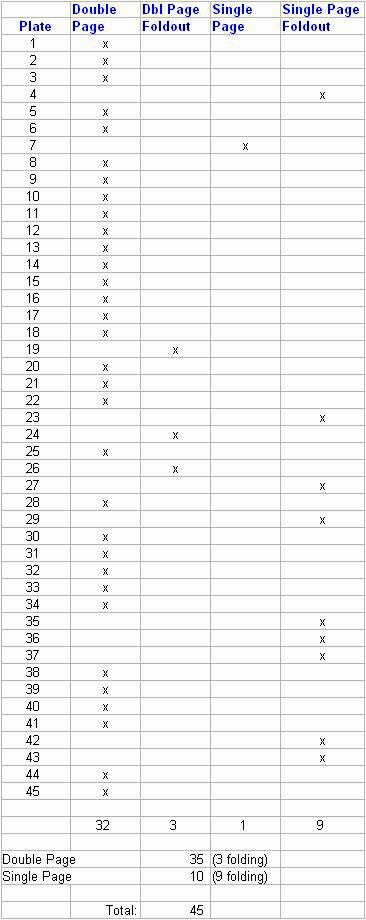
This set is a translation of the first English version. Below are the chapters from that set as presented in a 1906 facsimile edition (3 volume set).
Table of Contents -- Volumes 1~3
Volume 1.
Publishers' Note, xiii
Biographical Note on the Scheuchzer Family by Sir Archibald Geikie, xv
The Dedication, xxi
The Names of the Subscribers to the Original Edition, xxiii
The Author's Preface, xxix
The Life of the Author, by the Translator, xxxv
An Introduction by the Translator, xlvii
The History of Japan
BOOK I -- A GENERAL DESCRIPTION OF THE EMPIRE OF JAPAN
I. Journal of the author's voyage from Batavia to Siam, with an account of what happen'd during his Stay there, 1
II. The present State of the Court of Siam, with a description of Juthia, the Capital City and Place of the King's Residence, 30
III. The Author's departure from Juthia, down the River Meinam to the harbour, and from thence to Japan, 73
IV. Of the Empire of Japan in general, as to its situation and the largeness of its several Islands, 98
V. The Division and Sub-division of the Empire of Japan into its several Provinces; as also of its Revenue and Government, 114
VI. The Author's opinion of the true Origin and Descent of the Japanese, 131
VII. Of the Origin of the Japanese, according to their own fabulous Opinion, 152
VIII. Of the Climate of Japan, and its Produce as to Minerals and Metals, 160
IX. Of the Fertility of the Country as to Plants, 176
X. Of the plenty of the Country as to Beasts, Birds, Reptiles and Insects, 190
XI. Of Fish and Shells, 213
BOOK II -- OF THE POLITICAL STATE OF JAPAN
I. Names of the Gods, Demi-Gods and Emperors, who are mention'd in the Japanese Histories, as the first Monarchs and Governors of that Empire, 251
II. Of the Ecclesiastical Hereditary Emperors of Japan in general, of their Succession, Residence and Court; as also of the Chronology of the Japanese, 259
III. Of the Ecclesiastical Hereditary Emperors in particular, and first of those, who govern'd from the beginning of the Japanese Monarchy, till our Saviour's nativity, 273
IV. Of the Ecclesiastical Hereditary Emperors, who liv'd and govern'd with an unlimited Authority, from the Birth of our Saviour to Joritomo, the first Secular Monarch, 281
V. Of the Ecclesiastical Hereditary Emperors, who liv'd after Joritomo to the present time, 309
VI. Of the Crown-Generals and Secular Monarchs of Japan,from Joritomo to the Emperor Tsinajos now reigning, 334
Volume 2.
BOOK III -- OF THE STATE OF RELIGION IN JAPAN
I. Of the Religions of this Empire in general, and of the SINTOS Religion in particular, I
II. Of the SINTOS TEMPLES, belief and worship, 8
III. Of the SINTOS REEI, that is, their fortunate and Holidays, and the Celebration thereof, 19
IV. Of the SANGA, or Pilgrimage to ISJE, 33
V. Of the JAMMABOS,or Mountain-Priests, and other Religious Orders, 43
VI. Of the BUDSDO, or Foreign Pagan. Worship, and its Founder, 56
VII. Of the SIUTO, that is, the Doctrine and Way of Life of their Moralists and Philosophers, 67
BOOK IV -- OF NAGASAKI, THE PLACE OF RESIDENCE FOR FOREIGNERS: OF THEIR TRADE, ACCOMMODATION, ETC.
I. Of the Situation of the City of Nagasaki, and its Harbour; as also of its publick and private Buildings, 73
II. Of the Government of Nagasaki, 91
III. Of the Policy, or Regulation of the Streets of NAGASAKI; as also of the Government of the adjacent Country, 109
IV. Of the Temples and Clergy of this City, 130
V. Of the arrival and reception of the Portuguese and Castilians in Japan; of their Trade, and how they were banish'd the Empire, 152
VI. Of the Dutch Trade in Japan in general, 170
VII. Of the Dutch Trade in Japan in particular, and first of the several Corporations establish'd for this purpose, 198
VIII. Some more Particulars concerning the Dutch Trade in Japan, 209
IX. Of the way of Life, Trade, and Privileges of the Chinese in Japan, 248
X. Some Proclamations, Pasports, Orders, etc., mention'd in the foregoing Chapters, 259
BOOK V -- THE AUTHOR'S TWO JOURNIES TO THE EMPEROR'S COURT AT JEDO, THE CITY OF HIS RESIDENCE
I. Preparations for our Journey, with a Description of the manner of travelling in this country, 275
II. A general Description of the Way by Water and Land, from Nagasaki to Jedo, the Emperor's Residence, 290
III. A general Description of the several Edifices and Buildings, publick and private, we met along the Road, 299
IV. Of the Post-houses, Inns, Eating-houses, and Tea-booths, 316
V. Of the great Numbers of people, who daily travel on the Roads, 330
VI. Of our Journey to the Emperor's Court in general, and how we were accommodated on the road, 347
VII. Our Journey by Land from Nagasaki to Kokura, 362
VIII. Our voyage from Kokura to Osacca, 379
Volume 3.
Book V -- Continued -- THE AUTHOR'S TWO JOURNIES TO THE EMPEROR'S COURT AT JEDO, THE CITY OF HIS RESIDENCE
IX. Our journey from Osacca to Miaco, the residence of the Ecclesiastical Hereditary Emperors, with a description of both these cities, I
X. Our journey from Miaco to Fammamatz, being half way to Jedo, 25
XI. Our journey from Fammamatz to Jedo, the place of the Emperor's residence 46
XII. A description of the city of Jedo, its castle and palace, with an account of what happen'd during our stay there, our audience and departure, 73
XIII. Of our return from Jedo to Nagasaki, and what happen'd there, 101
XIV. Our second journey to court, 146
XV. Our second journey from Jedo to Nagasaki, 181
THE APPENDIX TO THE HISTORY OF JAPAN
I. The Natural History of the Japanese Tea; with an accurate description of that Plant, its culture, growth, preparation and uses, 215
II. Of the Paper Manufactures of the Japanese, 249
III. Of the cure of the Cholick by the Acupunctura, or Needle-pricking, as it is us'd by the Japanese, 263
IV. An Account of the Moxa, an excellent Caustic of the Chinese and Japanese; with a Scheme shewing, what parts of the human body are to be burnt with that plant in several distempers, 272
V. Some observations concerning Ambergreese, 292
VI. An Enquiry, whether it be conducive for the good of the Japanese Empire, to keep it shut up, as it now is, and not to suffer its Inhabitants to have any commerce with foreign nations, either at home or abroad, 301
The Second Appendix to the History of Japan, being part of an authentick Journal of a voyage to Japan, made by the English in the year 1673, 337
THE INDEX, 363
|


































